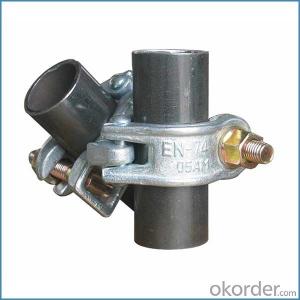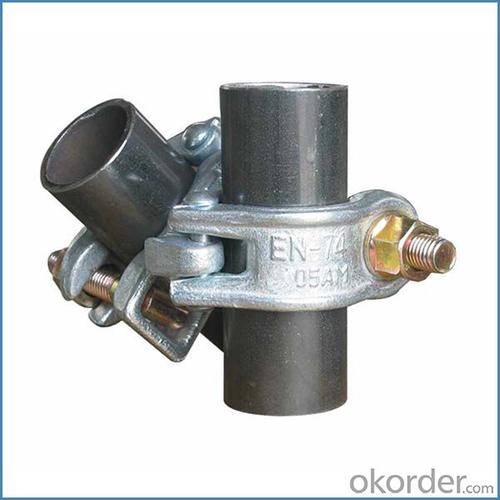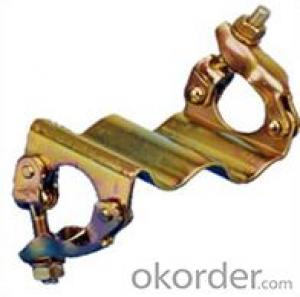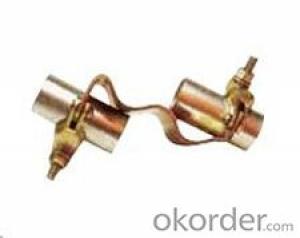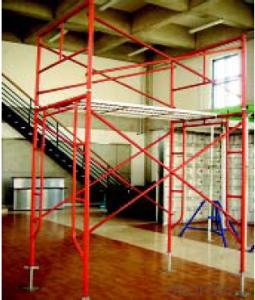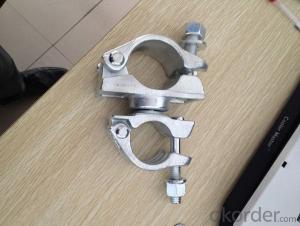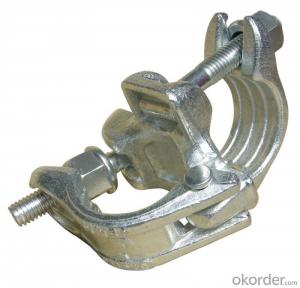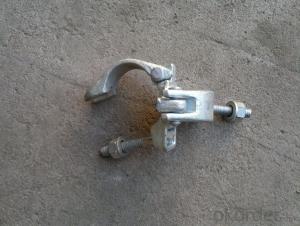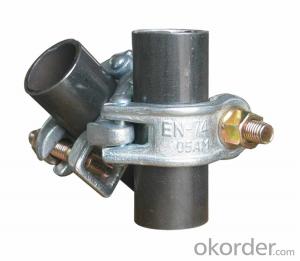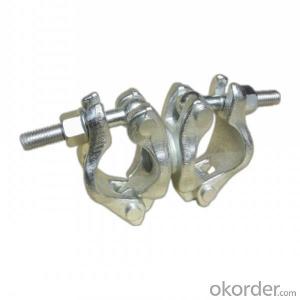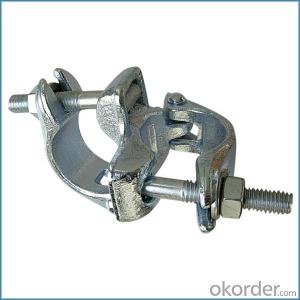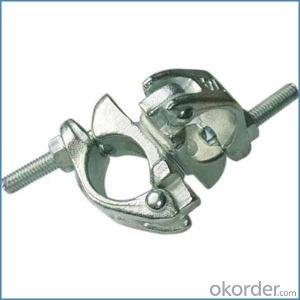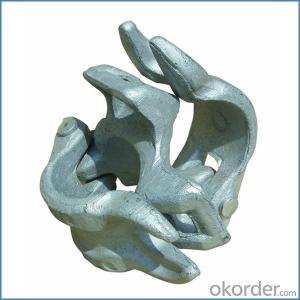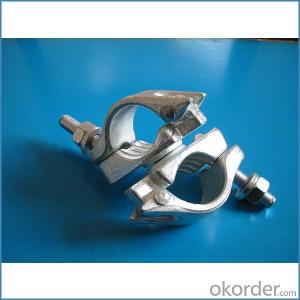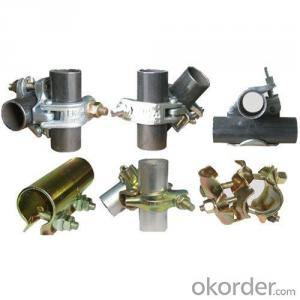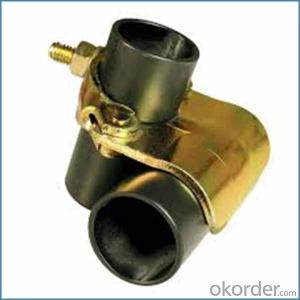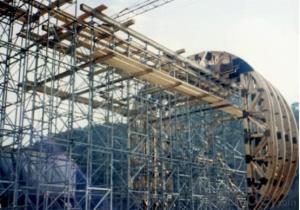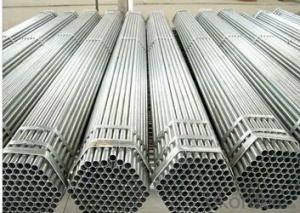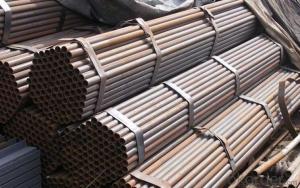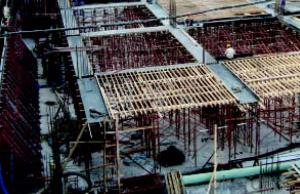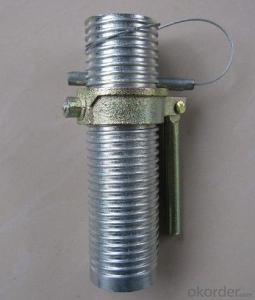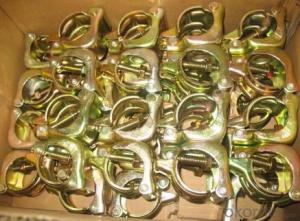Scaffolding Rapid Clamp british German Forged Type
- Loading Port:
- Tianjin
- Payment Terms:
- TT OR LC
- Min Order Qty:
- 1000 kg
- Supply Capability:
- 100000 kg/month
OKorder Service Pledge
OKorder Financial Service
You Might Also Like
Scaffolding Rapid Clamp british German Forged Type
Description
1.The scaffolding coupler is always used to connect the steel pipe as scaffolding system.
2.The often used coupler is swivel coupler and righ angle coupler .
3.We can provide types of scaffolding coupler according to your requirement.
4.Couoler can fix the 48.3mm scaffolding steel pipe tightly and make the whole scaffolding system more steadily.
Feature
(1)Excellent Anti-Breaking—Cold Pressed Steel
(2)Outstanding Resistance Deformation
(3)Strong Anti-Dropping Ability
Photo
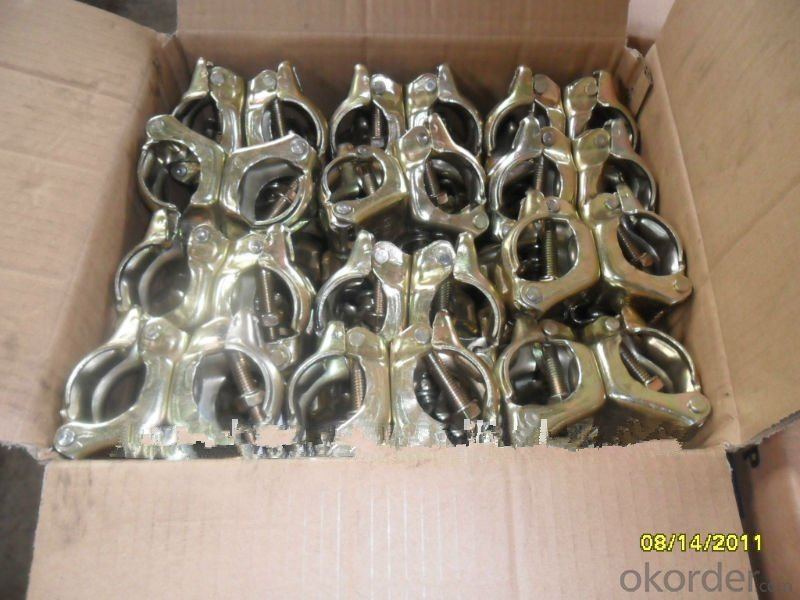
Parameter
| Material | Q235,345steel |
| Size | 48.3mm*48.3mm |
| Surface finish | Galvanized |
| Weight | 1.1kg around |
| Standard | BS1139,EN74 |
| Package | 25pcs/bag,steel pallet |
| Manufacture | As per customer requirement |
| Market | Africa, South America, the Middle East and Asia |
FAQ
Q: Are you a factory or trading company?
We are a state-owned corporation in China,dealing with various kinds of building materials.We have our holding subsidiaries.
Q: Where is your factory located? How can I visit there?
Our factory is located all around China.
Q: Can I get some samples?
Sample is free, customer only pay freight for the first time.
Q: Delivery?
10-30days. (5-15 containers)
Any question,feel free to contact us.
- Q: How do steel tube couplers attach to scaffolding tubes?
- Steel tube couplers attach to scaffolding tubes by being tightened onto the tubes using a bolt and nut mechanism. The coupler has two halves, each with a threaded hole. These halves are placed around the tubes, and the bolt is inserted through the holes and tightened with a nut, securely holding the tubes together.
- Q: Can steel tube couplers be used to connect different diameter tubes?
- No, steel tube couplers are designed to connect tubes of the same diameter.
- Q: Are there any specific guidelines for using steel tube couplers in high-rise scaffolding?
- Yes, there are specific guidelines for using steel tube couplers in high-rise scaffolding. These guidelines typically include factors such as load capacity, proper installation techniques, spacing requirements, and regular inspections to ensure the structural integrity and safety of the scaffolding system. Compliance with these guidelines is crucial to maintain the stability and strength of the scaffolding in high-rise construction projects.
- Q: Fastener type steel pipe scaffolding with wall pieces of what components
- It is recommended that you choose the East Rainbow waterproof products and standardized construction team, the East Rainbow is the best quality waterproof listed companies good Shi Tu 120 speed grams of protective liquid good Shi 120 speed grams of protective liquid Features: ◆ independent penetration: completely penetrate to ◆ the invisible waterproof material, visible waterproof effect; brushing does not change the grass-roots visual effects; ◆ simple operation: no matter a small area of ??brush, a large area, the formation of waterproof layer, to achieve the purpose of waterproof and moisture; Area spray, no construction experience, can be easily constructed
- Q: How do steel tube couplers perform in extreme weather conditions?
- Steel tube couplers are designed to be durable and reliable in a wide range of weather conditions, including extreme weather. These couplers are typically made from high-quality steel, which is known for its strength and resistance to corrosion. In extreme heat, steel tube couplers can withstand high temperatures without deteriorating or losing their structural integrity. They are also able to expand and contract without causing any damage or compromising the connection between the tubes. In cold weather, steel tube couplers remain strong and reliable. The steel material used in their construction is not prone to becoming brittle or weak in low temperatures, ensuring that the couplers can withstand the rigors of extreme cold without any issues. Additionally, steel tube couplers are designed to resist corrosion, making them suitable for use in coastal or humid areas where the risk of rusting is higher. They are often coated with protective coatings or galvanized to enhance their resistance to corrosion, ensuring their performance is not affected by the weather conditions. Overall, steel tube couplers have proven to be highly effective in extreme weather conditions. They are engineered to provide a secure and long-lasting connection between steel tubes, regardless of the temperature or environmental conditions.
- Q: Steel pipe scaffolding door, bowl button, button button, plate sales are what?
- Steel structure, activities board room sandwich panel tapping screw selection: roof: 7.5cm with 135 self-tapping nails; 10cm with 165 self-tapping nails. Wall board 5cm with 75 self-tapping screws; 7.5cm with 100 self-tapping nails; 10cm with 125 self-tapping nails Self-tapping screw, the English name Self-tappingScrew is a metal or non-metallic materials in the pre-drilling hole in the self-drilling with a female thread with a threaded fastener. Self-tapping screws are used for connection between thin metal plates (steel plates, saw boards, etc.).
- Q: Discuss the significance of the three scaffold scenes. How do these three scenes advance the plot of the novel?
- I think it was a bit of an allegory for doing your own homework.
- Q: What are the typical weight capacities of steel tube couplers in scaffolding applications?
- The weight capacities of steel tube couplers in scaffolding applications can differ based on the coupler's specific type and design. However, in general, steel tube couplers used in scaffolding are engineered and tested to safely support heavy loads. Take, for instance, a standard double coupler, which is commonly employed to connect two scaffold tubes at right angles. Typically, it can bear a weight of approximately 5,000 to 6,000 pounds (2,268 to 2,722 kilograms) without any risk of failure or collapse. Likewise, other kinds of steel tube couplers, like swivel couplers and beam clamps, also possess substantial weight capacities to ensure the stability and safety of the scaffolding system. Swivel couplers, designed to connect two scaffold tubes at any angle, usually have weight capacities ranging from 4,000 to 6,000 pounds (1,814 to 2,722 kilograms). Beam clamps, which are utilized to attach scaffold tubes to steel beams, can possess weight capacities ranging from 3,000 to 6,000 pounds (1,361 to 2,722 kilograms) or potentially more, depending on the specific model and design. It is important to recognize that these weight capacities are general guidelines and may differ due to factors such as the coupler's quality, the condition of the scaffold tubes, and the overall design and arrangement of the scaffolding system. It is always advisable to consult the manufacturer's specifications and guidelines for accurate weight capacity information and to ensure the safe and proper utilization of steel tube couplers in scaffolding applications.
- Q: How do steel tube couplers prevent tubes from rotating horizontally?
- Steel tube couplers prevent tubes from rotating horizontally by providing a secure and rigid connection between the tubes. These couplers are designed with a tight grip and often include internal teeth or threads that engage with the tubes, preventing any horizontal movement or rotation.
- Q: How do steel tube couplers accommodate different tube sizes or dimensions in scaffolding systems with non-standard or custom profiles?
- Steel tube couplers accommodate different tube sizes or dimensions in scaffolding systems with non-standard or custom profiles by providing a secure connection between the tubes. These couplers are designed to be adjustable and versatile, allowing for the connection of tubes of varying sizes and dimensions. Additionally, they are often equipped with adjustable bolts or clamps, which can be tightened to ensure a tight and stable fit. This flexibility and adjustability make steel tube couplers an ideal solution for accommodating different tube sizes or dimensions in scaffolding systems with non-standard or custom profiles.
Send your message to us
Scaffolding Rapid Clamp british German Forged Type
- Loading Port:
- Tianjin
- Payment Terms:
- TT OR LC
- Min Order Qty:
- 1000 kg
- Supply Capability:
- 100000 kg/month
OKorder Service Pledge
OKorder Financial Service
Similar products
Hot products
Hot Searches
Related keywords
